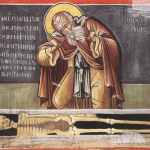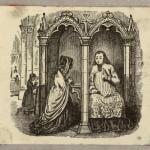In today’s Patheos column, I write about popular piety, how the forms of devotion that go viral, so to speak, among the people run to the melodramatic, the sensational and the sentimental. It’s easy to wince at this kind of thing, but easier still, sometimes, to wince at the people who are wincing. In his short story, “The Angel, Esmeralda,” Don DeLillo has a mob of South Bronx residents, relatively few of them observant Christians, claiming to see the face of a murdered homeless girl appear, of all places, on a billboard. Two nuns serving the neighborhood, Sisters Edgar and Gracie, debate the ultimate value of these visions. Sister Gracie begins:
“This is something for poor people to confront and judge and understand if the y can and we have to see it in that framework. The poor need visions, okay?”
“I believe you are patronizing the people you love,” Edgar said softly.
:That’s not fair.”
“You say the poor. But who else would saints appear to? Do saints and angels appear to bank presidents? Eat your carrots.”
I’m not sure either one has it exactly right. Nobody of any social class needs visions, and it’s not just the poor who will run with them — and with other extreme manifestations of zeal — off the nearest cliff. Members of all classes, including the clergy, joined the flagellant movement. The most infamous blood libel of all — that against the Jews of Trent concerning the murder of a child named Simon, who was later beatified — gained impetus from the support of the local bishop and magistrates. If the peasants are revolting, the apothecary or the almoner or the guy who plants hoods on the lord’s falcons could be more revolting still.
But the popular imagination is not always so morbid, nor are the most imaginative people always Catholic. For me, anyway, the most delightful supernatural meme exploded in Protestant Britain in the late summer of 1914. Shortly after the tiny British Expeditionary Force stopped the advance of a much larger body of Germans at Mons, the Evening News ran “The Bowmen, a story by the Welsh writer Arthur Machen. In Machen’s story, a soldier finds himself meditating on an image of St. George he recalls from the tablecloth in a vegetarian restaurant, along with the motto Adsit Anglis Sanctus Georgius (“May St. George always be a help to the English”).
The soldier, who knows Latin “and other useless things,” recites “the pious vegetarian motto.” Here’s what happens next.
For as the Latin scholar uttered his invocation he felt something between a shudder and an electric shock pass through his body. The roar of the battle died down in his ears to a gentle murmur; instead of it, he says, he heard a great voice and a shout louder than a thunder-peal crying, “Array, array, array!”
His heart grew hot as a burning coal, it grew cold as ice within him, as it seemed to him that a tumult of voices answered to his summons. He heard, or seemed to hear, thousands shouting: “St. George! St. George!”
“Ha! messire; ha! sweet Saint, grant us good deliverance!”
“St. George for merry England!”
“Harow! Harow! Monseigneur St. George, succour us.”
“Ha! St. George! Ha! St. George! a long bow and a strong bow.”
“Heaven’s Knight, aid us!”
And as the soldier heard these voices he saw before him, beyond the trench, a long line of shapes, with a shining about them. They were like men who drew the bow, and with another shout their cloud of arrows flew singing and tingling through the air towards the German hosts.
It turns out these shapes are the spirits of the longbowmen who slaughtered the French at Agincourt, some 499 years earlier. They do as well for the beastly Boches. With what now seems like horrible prescience, Machen ends by noting: “the Great General Staff decided that the contemptible English must have employed shells containing an unknown gas of a poisonous nature, as no wounds were discernible on the bodies of the dead German soldiers.”
“The Bowmen” was fiction — a cute piece of fluff, a harmless wartime pick-me-up. But many readers accepted it as fact. Religious magazines wrote Machen’s publisher, asking permission to reprint the story. In The Great War and Modern Memory, Paul Fussell cites this, along with other wartime urban myths, as a mass reversion to magical thinking. But what he doesn’t remark on is the sweetness of the story. Machen carefully wraps a longing for the age of chivalry in the absurdity of a tablecloth marked with a religious invocation. In choosing to believe it, the public showed excellent taste.
Even some stories that emerged straight from the imagination of the faithful show a wonderful turn for weirdness. In this category belong the various stories about St. Nicholas, who in Germany was said to travel on Christmas Eve with a bodyguard, a black man named Knecht Rupprecht (“Servant Rupert”), whose duties included beating disobedient children. However the Germans may have imagined Knecht Rupprecht, I’ve always pictured him looking exactly like Sonny Liston on George Lois’ famous Esquire cover. It would certainly explain how the Germans got so disciplined.
At their most harmless, the more fanciful forms of popular piety emerge from the same impulse that makes fans of Xena or Star Trek write fanfic: when you come to love some remote figure, you want to make that person more accessible. The easiest way to do that is to reinvent him, to one degree or another, in an image that tallies best with your own experience and expectations. I myself like to imagine Heaven as a call center, with the saints lodged snug in their cubicles, fielding pleas for intercession with unearthly patience.
“Hello, Heaven. Mental illness department. Dymphna speaking. How can I help you? Arrgh, your wife left you for your attorney. Well, darlin’, it’s not me your wantin’. I’ll transfer you to Rita in Lost causes. No, sir. I’m not implyin’ anything’. Wait just a moment if you please.
“Rita, love, I’ve got another cornuto on the line. Sure he’s got a bug up his arse. Shall I transfer?”
“Che palle. Go ahead.”
Let that take off.











